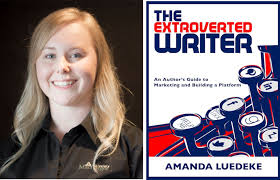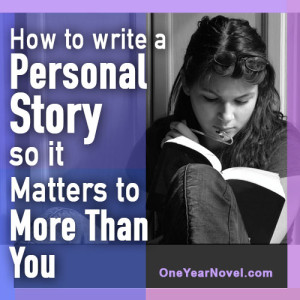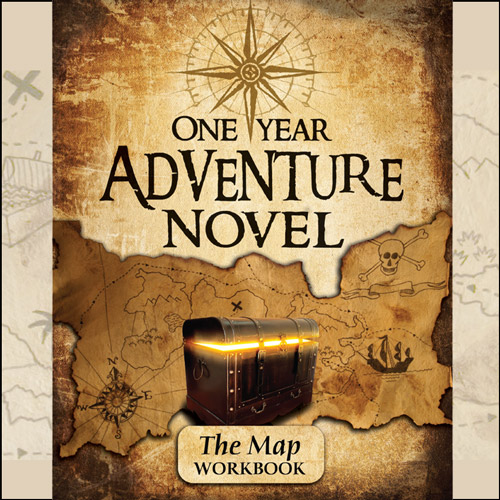How to Write a Personal Story So It Matters to More Than You
We’ve focused on short stories here lately. Today we look at another short form, nonfiction short stories, such as personal essays, anecdotes, and blog posts:
Publishing acclaimed novels. That’s the dream. Most One Year Adventure Novel students aspire to at least a little success.
I am an unusual member of the OYAN writing community in that I love writing creative nonfiction more than I do writing novels.
But most OYANers come to creative nonfiction in a roundabout way. If I may speak for our community as a whole, willing to do what it takes to get published as novelists, we accept that trying our hand at shorter pieces—short stories, poems, articles—is a good way to build publication credibility.
We read books like Amanda Luedeke’s The Extroverted Writer and recognize the value of building an author platform by investing in an author website and an author blog. Before we know it, we are no longer just writing fiction. We’ve crossed over into the realm of creative nonfiction, sharing our personal revelations, triumphs, and struggles so we can connect with fans and new readers.

This succinct and affordable resource on building an author platform is by a frequent speaker at our Summer Workshops: literary agent Amanda Luedeke (AMG Publishers). It is also available on Kindle.
How do we do this well? How do we avoid TMI (“too much information”) yet share our stories in a way that others will be able to relate to? This is a complex topic, but here are 8 fairly simple practices I have faith in as a creative nonfiction writer:
1. Zero in on the moment of revelation.
A blog is not a diary. A short story about how I’ve been learning to accept the creative limitations placed on me by chronic migraines is not the place to document every stage of my health journey. I have to focus. There is a place for writing just to process, but if we are sharing publicly it’s because we want to offer our revelation or experience to others. We have to zoom in on the action, even—and especially—if the action is only happening on the stage of our mind or heart.
2. Ruthlessly cut out backstory that would not be relatable to readers.
The only stops on the journey our readers need to make with us are those that directly bear on the revelation itself, not on our personal process. Cut out any material that does not help your story. It does not matter that A, B, and C really happened that same day. Unless they matter to the outcome of the story, we shouldn’t mention them.
Poor example:
I realized A while I was waiting in line to buy my ticket to Big Hero 6. But it wasn’t until the following week when I got my usual at Starbucks that I had time to think about it again. I sat by the window and listened to the hiss of stinging rain on the glass, sipping my mocha, when I began to feel the grief rise again. I couldn’t get the memories out of my head. I tried to focus on A but I just couldn’t. It took me a moment to realize that the water coursing down my face in my reflection in the window was not rain but my own tears.
Then a few weeks later, I was talking to my friend, Brandie, whom I’ve known since we were toddlers when we did—, and she recommended this book called—. I looked it up on Amazon and was dismayed to find it cost 80 cents more than I had in my bank account. But I get paid every two weeks (I work at—), so I was eventually able to buy it. It took me a long time to read it because—, but when I read this quote, it changed my life. You should read it too.
What is a reader supposed to make of this narrative? That if they stand in line to watch the same movie, visit Starbucks the following week, order the author’s usual (what size mocha?!), sit by a window while it is raining, and then find Brandie and read said book, they will be able to recreate the revelation for themselves? None of these markers in the process of the author have relevance for the reader. The only thing in this lengthy example we would want to keep is the quote itself—but not how we came to read it, and only if it’s short.
3. Stick to tone-setting details.
A few well-chosen details that convey emotion and hint at our tone as the writer are valid. Mr. S.’s mantra to use “precise and unexpected details,” applies to creative nonfiction as well. If we’re writing a humor piece, we could go ahead and include the melodramatic scene at the rain-streaked window. But, if we’re worried we may actually come off melodramatic in earnest, we would want to avoid cliché details and settings and hunt for something unexpected with more punch.
When it comes to creating emotion, we need to keep a firm grip on this mantra too: Less is more. As anyone who’s been the victim of TMI well knows.
4. Open a window into real emotions and ask honest questions.
To stay clear of TMI, and sometimes also to protect ourselves from exposure, we can make the mistake of writing about emotional experiences in vague or clinical terms. But telling about emotions does not have nearly the impact that showing emotions does. Surprise, surprise.
I often describe my emotional state in a cameo: identifying and then describing one brief scene from my life that epitomizes my emotions and opinions. Instead of telling a reader how I thought or felt, I try to show them how my thoughts or feelings impact me. Vulnerability and honesty are critical to personal pieces, and when crafted and honed, they are not the same thing as TMI.
It can also be effective to stage a dialogue between bickering points of view within your own head.
This genre is called creative nonfiction for a reason.
5. Treat your “past self” with dignity.
When we write about opinions we’ve held in the past and about our earlier behavior, we need to approach our “past self” as we would our reader: with empathy, gentleness, and barbless humor. The way I portray my weaknesses and my “less-transformed” self is how my readers will perceive my view of them. So I avoid the “back when I was an idiot, I did/said/thought such and such, but now I know better.” I don’t want to make my readers feel bad for still being an “idiot”—they probably won’t be back if I do.
6. Don’t give advice.
People don’t want advice; they want to find company—even friendship—in a shared struggle or experience. The impulse to give advice and present our stories as a neat how-to for the benefit of others is normal. But we need to push back against that impulse and use “I” and “we” not “you.” For example, I wrote much of the draft for this post as a series of “you should do this,” and “you shouldn’t do that.” But even though this is a how-to post, I went back and changed my language to include myself. After all, I am also coaching myself.
7. Watch your tense.
Watch for lapses into the past tense when emotions and thoughts are really present tense. That would be a distancing maneuver—one I see and am tempted to use all the time.
8. Consider side-audiences.
We often expect our readers to think much as we do—after all, isn’t that why they read our stuff? But we need to challenge ourselves to add nuance to our creative nonfiction, especially if the topic is controversial.
Not only do I want to avoid driving others away with dollops of advice or snide remarks, I also want to welcome people who do not think the way I do into the intellectual space of my piece. For example, in a post about my passion for higher education, I would be careful to include that (1) I don’t pretend to know what is best for other people; and (2) I acknowledge that not all higher education is well-designed. I don’t want to sideline readers who have a negative experience of academia or who feel pressured to go on with studies they have no passion for.
If our opinion can’t be nuanced within the word count limit, we should consider writing more than one post/story. It is not worthwhile to alienate people just because showing consideration is inconvenient.
BONUS TIPS FOR BLOGGING
+ Use lots of white space. The way people take in text on the web is different from the way they read on paper. Perfectly normal paragraphs need to be broken up into smaller ones when presented online.
+ Mind the reader’s eyes. Consider bolding key phrases. This creates visual stepping stones to move the reader’s eyes down the page, so that they keep scrolling. But remove strings of italics and all unusual fonts. You don’t want to weary your reader’s eyes.
+ Set a word count. There are many opinions on the ideal length for a blog post, but want to know a secret? When we use white space, we buy ourselves more of our reader’s valuable time.
+ Never draw attention to lapses as a blogger. I have a personal commitment never to employ “I know it’s been a while, but I am back,” or to make promises I can’t keep, such as “From now on I will be posting every week.” Proof is in the pudding. Don’t waste your reader’s time with apologies and entreaties for their loyalty; just write. And chances are, if we don’t say anything, they won’t notice.
…
If you keep a blog or write about your own life, what are your goals and how do you meet them?
…
Tineke Bryson works for One Year Adventure Novel as a kind of jane-of-all-trades, but her favorites trade of the lot is editing. Previous to OYAN, she graduated from Houghton College with an Honors in Writing and then worked as an editor for a large para-church organization.





i need help finding a story goal. my story is an adventure novel set in old england. i am using my old class for my hero/cheer sqaud myteacher is the metor. can u give me atip
Hi, Elly! Are you a One Year Adventure Novel student?